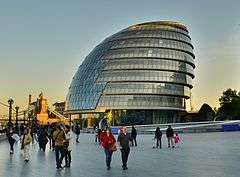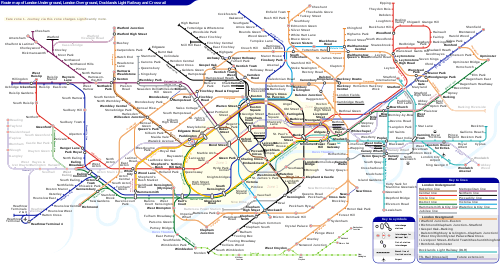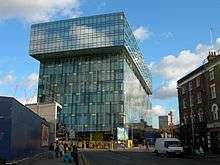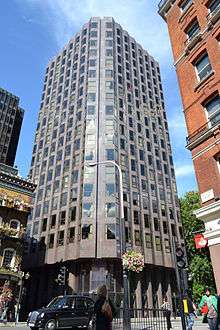Transport for London
.svg.png) | |
|
Area of responsibility within England | |
| Abbreviation | TfL |
|---|---|
| Formation | 3 July 2000 (Greater London Authority Act 1999) |
| Type | Statutory corporation |
| Legal status | Executive agency within GLA |
| Purpose | Transport authority |
| Headquarters | Windsor House, Victoria Street, Westminster, London |
Region served | Greater London |
Chairman |
Mayor of London Sadiq Khan |
| Mike Brown | |
Main organ | |
Parent organisation | Greater London Authority (GLA) |
Budget | 2015-16: £11.5 billion (40% of this from fares)[1] |
Staff | 28,000 |
| Slogan | "Every Journey Matters" |
| Website |
tfl |
 |
| This article is part of a series on the politics and government of London |
|
|

Transport for London (TfL) is a local government body responsible for the transport system in Greater London, England.[2] Its head office is in Windsor House in the City of Westminster.[2]
TfL has responsibility for London's network of principal road routes, for various rail networks including the London Underground, London Overground, Docklands Light Railway and TfL Rail, for London's trams, buses and taxis, for cycling provision, and for river services. The underlying services are provided by a mixture of wholly owned subsidiary companies (principally London Underground), by private sector franchisees (the remaining rail services, trams and most buses) and by licensees (some buses, taxis and river services). TfL is also responsible, jointly with the national Department for Transport (DfT), for commissioning the construction of the new Crossrail line, and will be responsible for franchising its operation once completed.[3]
In 2015-16, TfL had a budget of £11.5 billion, 40% of which comes from fares. The rest comes from government funding (23%), borrowing (20%), other income (9%) and Crossrail funding (8%).[1]
On 21 January 2016, it was announced that the responsibility for franchising all of London's inner suburban rail services would be transferred from the DfT to TfL. This transfer will take place as current franchises fall due for renewal, and the DfT will continue to be responsible for franchising outer suburban and intercity services to and from London. This announcement effectively extends the existing franchise arrangements for the London Overground and TfL Rail suburban systems to London's remaining inner suburban lines, and mirrors arrangements for the provision of inner-suburban rail lines in other cities, for example Merseyrail in Liverpool.[4]
History
TfL was created in 2000 as part of the Greater London Authority by the Greater London Authority Act 1999.[5] It gained most of its functions from its predecessor London Regional Transport in 2000. The first Commissioner of TfL was Bob Kiley. The first Chair was then-Mayor of London Ken Livingstone, and the first Deputy Chair was Dave Wetzel. Livingstone and Wetzel remained in office until the election of Boris Johnson as Mayor in 2008. Johnson took over as Chairman, and in February 2009 fellow-Conservative Daniel Moylan was appointed as his Deputy.
TfL did not take over responsibility for the London Underground until 2003, after the controversial Public-private partnership (PPP) contract for maintenance had been agreed. Management of the Public Carriage Office had previously been a function of the Metropolitan Police.
Transport for London Group Archives holds business records for TfL and its predecessor bodies and transport companies. Some early records are also held on behalf of TfL Group Archives at the London Metropolitan Archives.
After the bombings on the underground and bus systems on 7 July 2005, many staff were recognised in the 2006 New Year honours list for the work they did. They helped survivors out, removed bodies, and got the transport system up and running, to get the millions of commuters back out of London at the end of the work day. Those mentioned include Peter Hendy, who was at the time Head of Surface Transport division, and Tim O'Toole, head of the Underground division, who were both awarded CBEs.[6][7][8] Others included David Boyce, Station Supervisor, London Underground (MBE);[6] John Boyle, Train Operator, London Underground (MBE);[6] Peter Sanders, Group Station Manager, London Underground (MBE);[6] Alan Dell, Network Liaison Manager, London Buses (MBE)[6] and John Gardner, Events Planning Manager (MBE).[8]
On 1 June 2008, the drinking of alcoholic beverages was banned on Tube and London Overground trains, buses, trams, Docklands Light Railway and all stations operated by TfL across London but not those operated by other rail companies.[9][10] Carrying open containers of alcohol was also banned on public transport operated by TfL. The Mayor of London and TfL announced the ban with the intention of providing a safer and more pleasant experience for passengers. There were "Last Round on the Underground" parties on the night before the ban came into force. Passengers refusing to observe the ban may be refused travel and asked to leave the premises. The Greater London Authority reported in 2011 that assaults on London Underground staff had fallen by 15% since the introduction of the ban.[11]
TfL commissioned a survey in 2013 which showed that 15% of women using public transport in London had been the subject of some form of unwanted sexual behaviour but that 90% of incidents were not reported to the police. In an effort to reduce sexual offences and increase reporting, TfL—in conjunction with the British Transport Police, Metropolitan Police Service, and City of London Police—launched Project Guardian.[12]
In 2014, Transport for London launched the 100 years of women in transport campaign in partnership with the Department for Transport, Crossrail,[13] Network Rail,[14] Women's Engineering Society[15] and the Women's Transportation Seminar (WTS). The programme is a celebration of the significant role that women have played in transport over the past 100 years, following the centennial anniversary of the First World War, when 100,000 women entered the Transport industry to take on the responsibilities held by men who enlisted for military service.[16]
Organisation
TfL is controlled by a board whose members are appointed by the Mayor of London,[17] a position held by Sadiq Khan since May 2016. The Commissioner of Transport for London reports to the Board and leads a management team with individual functional responsibilities.
The body is organised in three main directorates and corporate services, each with responsibility for different aspects and modes of transport. The three main directorates are:
- London Underground, responsible for running London's underground rail network, commonly known as the tube, and managing the provision of maintenance services by the private sector. This network is sub-divided into three service delivery units:
- BCV: Bakerloo, Central, Victoria and Waterloo & City lines.
- JNP: Jubilee, Northern and Piccadilly lines.
- SSL (Sub Surface Lines): Metropolitan, District, Circle and Hammersmith & City lines.
- London Rail, responsible for:
- Co-ordination with the operators that provide National Rail service within London.
- London Overground and TfL Rail, although actual operation is undertaken by a private sector concessionaire and maintenance by Network Rail.
- Docklands Light Railway: normally abbreviated DLR, this is the automatically driven light rail network in East London and South London, although actual operation and maintenance is undertaken by a private sector concessionaire.
- London Trams, responsible for managing London's tram network, by contracting to private sector operators. At present the only tram system is Tramlink in South London, but others are proposed.
- Surface transport, consisting of:
- London Buses, responsible for managing the red bus network throughout London and the East London Transit which is a Bus Rapid Transit in East London, largely by contracting services to private sector bus operators. Incorporating CentreComm, London Buses Command & Control Centre, a 24-hour Emergency Control Centre based in Southwark.
- London Dial-a-Ride, which provides community transport services throughout London.
- London River Services, responsible for licensing and coordinating passenger services on the River Thames within London.
- London Streets, responsible for the management of London's strategic road network.
- London congestion charge which drivers who drive in Central London between Monday and Friday must pay a fee.
- Public Carriage Office, responsible for licensing the famous black cabs and other private hire vehicles.
- Victoria Coach Station, which owns and operates London's principal terminal for long distance bus and coach services.
- "Delivery Planning" which promotes cycling in London.
- "Special Projects Team" manages the contract with Serco for the Santander Cycles scheme.
- Walking, which promotes better pedestrian access and better access for Walking in London.
- London Road Safety Unit, which promotes safer roads through advertising and road safety measure.
- Community Safety, Enforcement and Policing, responsible for tackling fare evasion on buses, delivering policing services that tackle crime and disorder on public transport in cooperation with the Metropolitan Police Service's Transport Operational Command Unit (TOCU) and the British Transport Police.
- Traffic Enforcement, responsible for enforcing traffic and parking regulations on the red routes.
- Freight Unit, which has developed the "London Freight Plan"[18] and is involved with setting up and supporting a number of Freight Quality Partnerships covering key areas of London.
TfL owns and operates the London Transport Museum in Covent Garden, a museum that conserves and explains London's transport heritage. The museum also has an extensive depot, situated at Acton, that contains material impossible to display at the central London museum, including many additional road vehicles, trains, collections of signs and advertising materials. The depot has several open weekends each year. There are also occasional heritage train runs on the Metropolitan line.
TfL has developed an electronic "Journey Planner",[19] which enables users to plan journeys by all forms of public transport and bicycle in and around London.
Operations centre

TfL's Surface Transport and Traffic Operations Centre (STTOC) was officially opened by Prince Andrew, Duke of York in November 2009.[20][21] The centre monitors and coordinates official responses to traffic congestion, incidents and major events in London.[22] London Buses Command and Control Centre (CentreComm), London Streets Traffic Control Centre (LSTCC) and the Metropolitan Police Traffic Operation Control Centre (MetroComm) were brought together under STTOC.[22]
STTOC played an important part in the security and smooth running of the 2012 Summer Olympics.[22] The London Underground Network Operations Centre is now located on the fifth floor of Palestra and not within STTOC.[23][24] The centre featured in the 2013 BBC Two documentary series The Route Masters: Running London's Roads.
Connect project
Transport for London introduced the "Connect" project for radio communications during the 2000s, to improve radio connections for London Underground staff and the emergency services.[25][26] The system replaced various separate radio systems for each tube line, and was funded under a private finance initiative. The supply contract was signed in November 1999 with Motorola as the radio provider alongside Thales. Citylink's shareholders are Thales Group (33 per cent), Fluor Corporation (18%), Motorola (10%), Laing Investment (19.5%) and HSBC (19.5%). The cost of the design, build and maintain contract was £2 billion over twenty years.
Various subcontractors were used for the installation work, including Brookvex and Fentons.
A key reasoning for the introduction of the system was in light of the King's Cross fire disaster, where efforts by the emergency services were hampered by a lack of radio coverage below ground. Work was due to be completed by the end of 2002, although suffered delays due to the necessity of installing the required equipment on an ageing railway infrastructure with no disruption to the operational railway. On 5 June 2006 the London Assembly published the 7 July Review Committee report, which urged TfL to speed up implementation of the Connect system.[25]
The East London line was chosen as the first line to receive the TETRA radio in February 2006, as it was the second smallest line and is a mix of surface and sub surface. In the same year it was rolled out to the District, Circle, Hammersmith & City, Metropolitan and Victoria lines, with the Bakerloo, Piccadilly, Jubilee, Waterloo & City and Central lines following in 2007.[27] The final line, the Northern, was handed over in November 2008.
The 2010 TfL investment programme included the project "LU-PJ231 LU-managed Connect communications", which provided Connect with a new transmission and radio system comprising 290 cell sites with two to three base stations, 1,400 new train mobiles, 7,500 new telephone links and 180 CCTV links.[26]
Fares

Most of the transport modes that come under the control of TfL have their own charging and ticketing regimes for single fare. Buses and trams share a common fare and ticketing regime, and the DLR, Overground, Underground, and National Rail services another.
Zonal fare system
Rail service fares in the capital are calculated by a zonal fare system. London is divided into eleven fare zones, with every station on the London Underground, London Overground, Docklands Light Railway and, since 2007, on National Rail services, being in one, or in some cases, two zones. The zones are mostly concentric rings of increasing size emanating from the centre of London. They are (in order):
Travelcard
Superimposed on these mode-specific regimes is the Travelcard system, which provides zonal tickets with validities from one day to one year, and off-peak variants. These are accepted on the DLR, buses, railways, trams, the Underground and provides a discount on many river services fares.
Oyster card
The Oyster card is a contactless smart card system introduced for the public in 2003, which can be used to pay individual fares (pay as you go) or to carry various Travelcards and other passes. It is used by holding the card close to the yellow card reader. Card readers are found on ticket gates where otherwise a paper ticket could be fed through, allowing the gate to open and the passenger to walk through, and on stand-alone Oyster validators, which do not operate a barrier. Since 2010, Oyster Pay as you go has been available on all National Rail services within London. Oyster Pay as you go has a set of daily maximum charges that are the same as buying the nearest equivalent Day Travelcard.
Contactless payments
Contactless Visa, Maestro, MasterCard and American Express Debit and Credit cards issued in the UK are accepted for travel on London Underground, London Overground, Docklands Light Rail, most National Rail, London Tramlink and Bus services. This works in the same way for the passenger as an Oyster Card, including the use of capping and reduced fares compared to paper tickets.
Apple Pay
Transport for London also accepts Apple Pay in the same way as contactless payment cards,[28] the fares would be the same as those charged on a debit or credit card and customers would benefit from the same daily capping. Since then, TfL has become the most popular Apple Pay merchant following the UK launch.[29][30][31][32]
Identity and marketing

Each of the main transport units has its own corporate identity, formed by differently coloured versions of the standard roundel logo and adding appropriate lettering across the horizontal bar. The roundel rendered in blue without any lettering represents TfL as a whole (see Transport for London logo), as well as used in situations where lettering on the roundel is not possible (such as bus receipts, where a logo is a blank roundel with the name "London Buses" to the right). The same range of colours is also used extensively in publicity and on the TfL website.
Transport for London has always mounted advertising campaigns to encourage use of the Underground. For example, in 1999, they commissioned artist Stephen Whatley to paint an interior - 'The Grand Staircase' – which he did on location inside Buckingham Palace. This painting was reproduced on posters and displayed all over the London Underground.[33]
In 2010 they commissioned artist Mark Wallinger to assist them in celebrating the 150th anniversary of the Underground, by creating the Labyrinth Project, with one painting to hang permanently in each of the Tube's 270 stations.[34]
In 2015, in partnership with the London Transport Museum and sponsored by Exterion Media,[35][35] TfL launched Transported by Design,[36] a 18 months programme of activities. The intention is to showcase the importance of both physical and service design across London's transport network. In October 2015, after two months of public voting, the black cab topped the list of the favourite London transport icons, which also included the original Routemaster bus and the Tube map, among others.[37] In 2016, the programme is holding exhibitions,[38] walks[39] and a festival at Regent Street on 3 July.[40][41]
See also
- Articulated buses in London
- Passenger transport executive
- Selective vehicle detection
- Transport in London
References
- 1 2 "TfL funding".
- 1 2 "Company information". Transport for London. 2013. Retrieved 10 August 2013.
- ↑ "Our role". Transport for London. Retrieved 29 January 2016.
- ↑ "A new approach to rail passenger services in London and the south east" (PDF). Department for Transport and Transport for London. January 2016. Retrieved 29 January 2016.
- ↑ "Legislative framework". Transport for London. Retrieved 6 September 2008.
- 1 2 3 4 5 Alan Hamilton (16 February 2006). "It was all just part of the job, say honoured 7/7 heroes". The Times. Retrieved 22 May 2011.
- ↑ "Queen hails brave 7 July workers". BBC News. 15 February 2006. Retrieved 22 May 2011.
- 1 2 "Two TfL July 7 heroes honoured in New Years List". Transport for London. 2 January 2007. Retrieved 22 May 2011.
- ↑ "Revellers' farewell to Tube alcohol". Metro. 1 June 2008. Retrieved 10 August 2013.
- ↑ "Johnson bans drink on transport". BBC News. 7 May 2008. Retrieved 6 September 2008.
- ↑ "Londoners continue to back Mayor's booze ban". Greater London Authority. 5 May 2011. Retrieved 10 August 2013.
- ↑ Bates, Laura (1 October 2013). "Project Guardian: making public transport safer for women". The Guardian. Retrieved 17 September 2014.
- ↑ http://www.crossrail.co.uk/news/articles/crossrail-partners-with-women-into-construction
- ↑ http://www.onemk.co.uk/news/2015/6/network-rail-senior-manager-shares-experiences-26767427.html
- ↑ http://www.wes.org.uk/100yowit
- ↑ http://www.infrastructure-intelligence.com/article/jun-2014/first-100-years-women-transport
- ↑ "Board members". Transport for London. 2013. Retrieved 10 August 2013.
- ↑ "Freight". Transport for London. Retrieved 6 September 2008.
- ↑ "Journey Planner". Transport for London. Retrieved 6 September 2008.
- ↑ "HRH The Duke of York opens state of the art transport control centre". Archived from the original on 24 June 2013. Retrieved 24 June 2013.
- ↑ "Duke of York opens TfL control centre at Palestra in Blackfriars Road". Archived from the original on 24 June 2013. Retrieved 24 June 2013.
- 1 2 3 "Evidence for Transport Committee's investigation into 2012 transport". Archived from the original (PDF) on 24 June 2013. Retrieved 24 June 2013.
- ↑ "Transport for London Board Agenda Item 5, 2 November 2011". Archived from the original (PDF) on 24 June 2013. Retrieved 24 June 2013.
- ↑ "Southwark chosen for LUL command and control centre". Archived from the original on 24 June 2013. Retrieved 24 June 2013.
- 1 2 "TfL keeps schtum on underground radio plans". The Register. 6 June 2006. Retrieved 19 June 2014.
- 1 2 "TfL investment programme - London Underground" (PDF). Transport for London. 2010. p. 10. Retrieved 19 June 2014.
- ↑ "Response from the Chief Engineers' Directorate of London Underground to the OFCOM Consultative Document "Spectrum Trading Consultation"" (PDF). Ofcom. November 2003. p. 10. Retrieved 19 June 2014.
- ↑ https://tfl.gov.uk/info-for/media/press-releases/2015/tfl-to-accept-apple-pay-on-public-transport
- ↑ Mortimer, Natalie (20 July 2015). "TfL proves most popular retailer on Apple Pay UK following launch". The Drum. Retrieved 22 July 2015.
- ↑ Titcomb, James (20 July 2015). "How London's transport crunch forged a contactless revolution". The Telegraph. Retrieved 22 July 2015.
- ↑ Gibbs, Samuel (16 July 2015). "TfL cautions users over pitfalls of Apple Pay". The Guardian. Retrieved 22 July 2015.
- ↑ "Apple Pay". Transport for London. Retrieved 22 July 2015.
- ↑ London Transport Museum, Stephen B. Whatley profile
- ↑ Mark Brown (7 February 2013). "Tube celebrates 150th birthday with labyrinth art project". The Guardian. Retrieved 7 February 2013.
- 1 2 http://www.exterionmedia.com/uk/who-we-are/news/exterion-media-sponsors-tfls-transported-by-design-programme/
- ↑ https://tfl.gov.uk/campaign/transported-by-design
- ↑ https://londonist.com/2015/09/vote-now-for-london-s-best-transport-design-icon
- ↑ https://londonist.com/2015/11/london-transport-museum-new-gallery
- ↑ http://www.timeout.com/london/things-to-do/winter-wanders
- ↑ http://www.eventmagazine.co.uk/tfl-announces-plans-regent-street-design-festival/associations/article/1359387
- ↑ http://www.regentstreetonline.com/events/2016-on-regent-street
External links
| Wikimedia Commons has media related to Transport for London. |
- Official website
- London Group of Campaign for Better Transport
- London TravelWatch
- Transport for London companies grouped at OpenCorporates
| Preceded by London Regional Transport |
Transport for London 2000–present |
Succeeded by Current |

